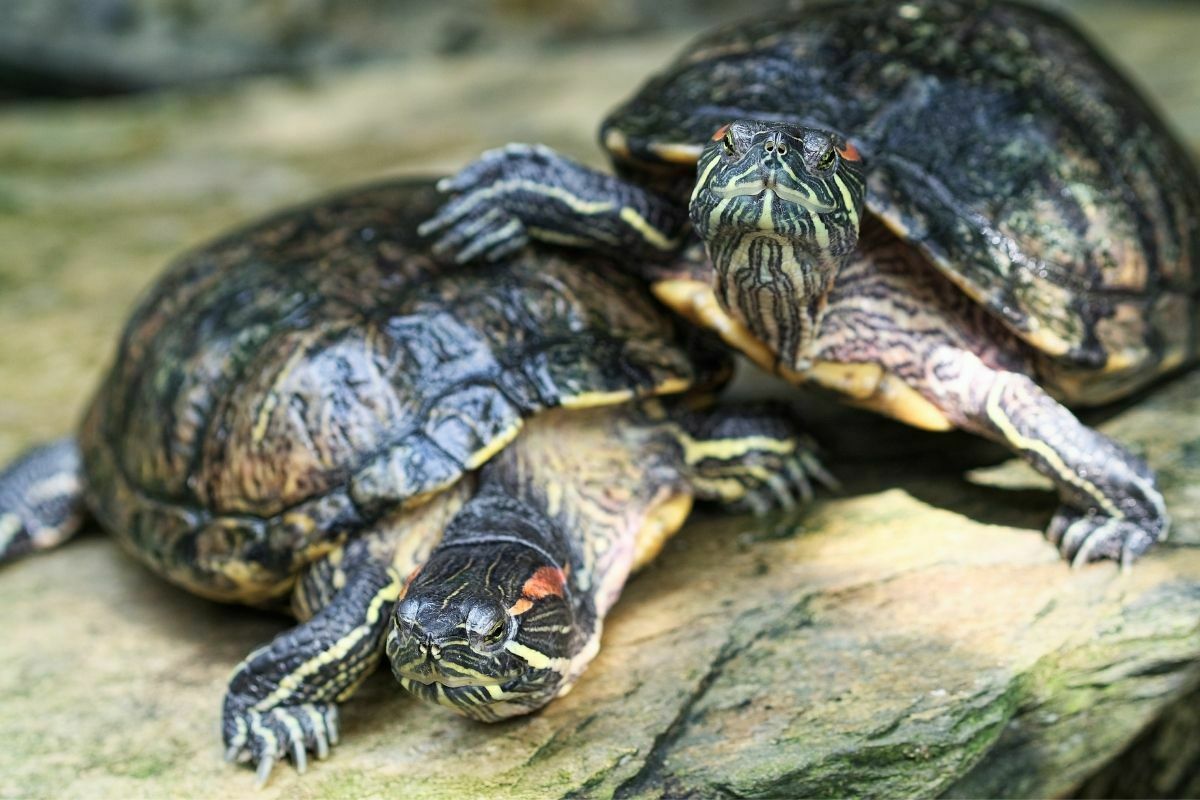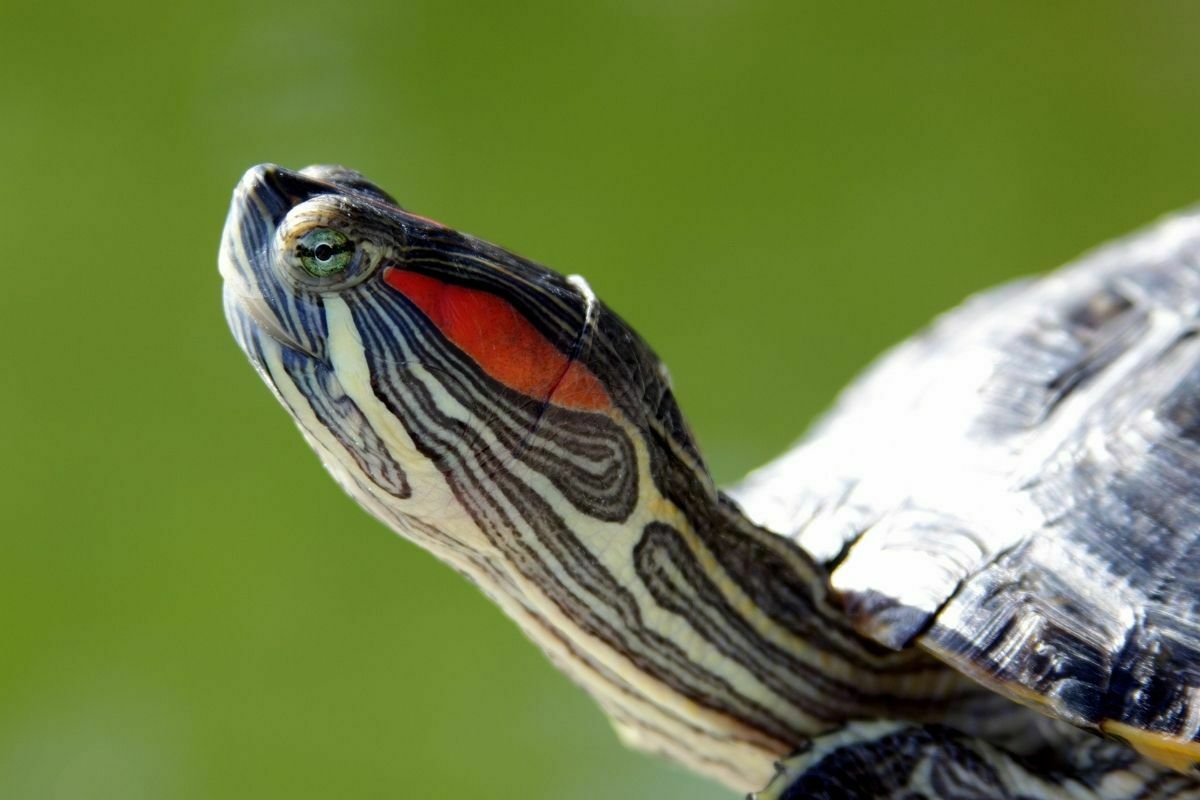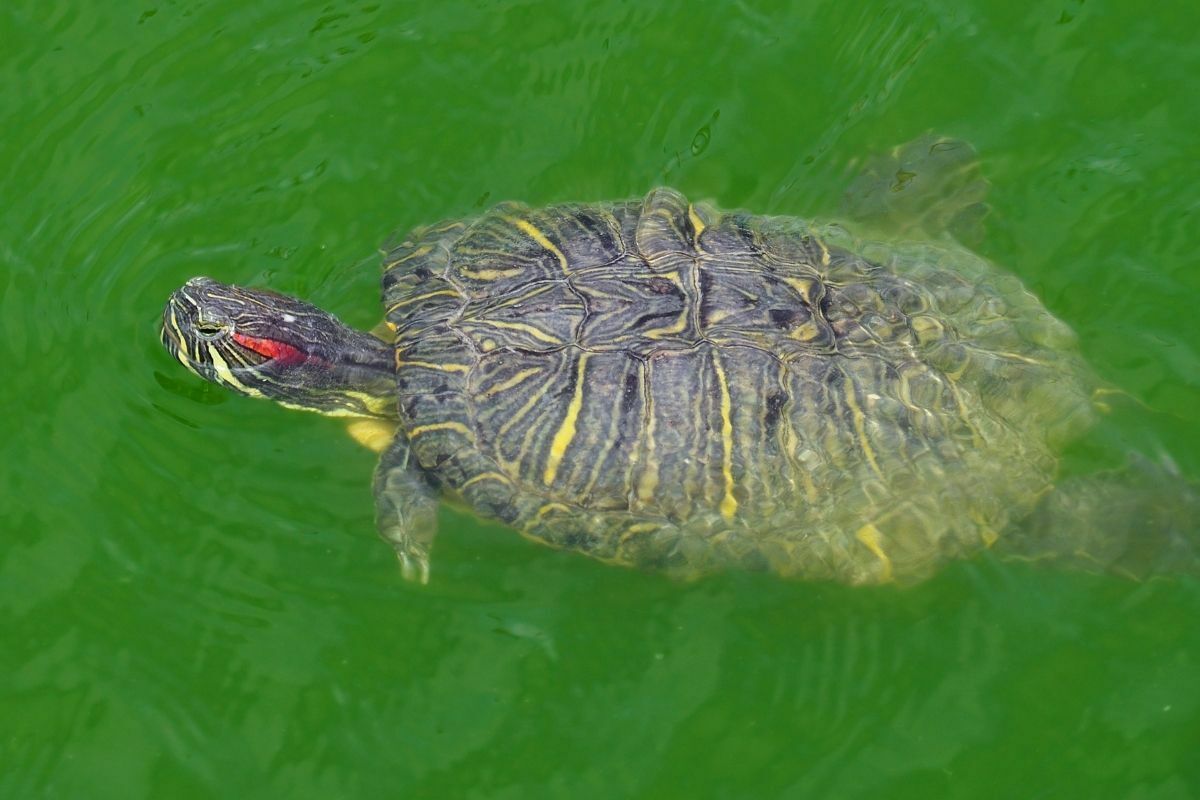The Red Eared Slider Turtle is a species of turtle found in the central United States and Northern Mexico. It is one of the most common pet turtle species in the US.

Their red stripes and yellow markings make them attractive to look at. However, these turtles do need a significant amount of care.
The average lifespan for this species is not as great as some other pet turtles, and if you have an older or sickly individual, it may not live very long.
If you are looking for a good way to increase your turtle’s lifespan, then read on!
We take a look at how long red-eared slider turtles can live and the best ways to give them a healthy and long life.
How Long Can A Pet Red-Eared Slider Turtle Live?
The lifespan of red-eared slider turtles varies based on their size, gender, health condition, and environment.
A lot of pet turtles can live for a relatively long time. Some species even live longer than their owners!
A healthy adult red-eared slider turtle may live up to 40 years. However, their lifespan may be shortened significantly if they are sick or injured.
If you treat your pet turtle the right way, it will have a much better chance of living a long life.
How Long Can A Red-Eared Slider Turtle Live In The Wild?
Similar to pet turtles, wild red-eared slider turtles also need a balanced diet, plenty of water, and the right temperature to thrive.
Although wild turtles are more likely to find this in the wild, they are often threatened by different predators.
When turtles hatch, their immune system is very weak. This often means their lifespan is relatively short.
Young slider turtles that survive their first years have a much better chance to live a long life.
Most red-eared slider turtles in the wild live for around 30 years.
Red-Eared Slider Turtles: The Basics

Red-red slider turtles are a very popular turtle species found in many homes around the US and the world.
Let’s take a look at what makes red-eared sliders so popular with pet owners.
Appearance
Red-eared sliders have an olive green to brown head with bright yellow stripes on the side and red streaks behind the ear.
You will notice that the shell of these turtles is much more dome-shaped than other turtle species.
The rest of their body is usually dark green with some yellow patches and stripes.
You can also find some variations of these colors, such as an albino or pastel type, which are much paler in color.
However, they still have the typical yellow markings of sliders.
The appearance of male and female red-eared sliders is slightly different. Females can be spotted because of their shorter nails.
In comparison, male red-eared slider turtles have longer fingernails on their front legs, and they also sport a long, thin tail.
Habitat
Red-eared sliders are semi-aquatic turtles. They spend most of their lives in freshwater as well as on land.
In the wild, red-eared slider turtles prefer to stay near bodies of freshwater such as rivers, lakes, ponds, swamps, marshes, and other wetlands.
They can swim well and use their webbed feet to move through the water.
These freshwater turtles spend most of their lives hunting for food or bathing in the sun while sitting on logs or rocks.
Turtles are reptiles, which means they’re cold-blooded animals. They don’t generate heat as mammals do.
They rely on external sources such as sunlight to regulate their body temperatures, so this is why you often see them basking and perched on rocks.
Red-eared sliders are very active animals. They can travel some distance, so when you set up a tank for these reptiles, you must imitate their natural habitat.
Behavior/Temperament
Red-eared slider turtles are active reptiles who spend a lot of time foraging for food, swimming, or bathing in the sun.
In the wild, you will find them in small groups that come together as you bask on the same rock.
Although they do bask together, they are not usually social animals. Wild sliders can be fierce and aggressive during feeding and mating times.
This aggression is directed towards their species as well as other turtles.
Luckily, pet sliders are much more docile, and they do not tend to display this aggressive behavior.
This is the reason why your pet red-eared slider turtle will likely sit next to the heat source, enjoying the comfortable temperature.
These pets also want to swim regularly and need a reasonably large area to do this.
You will find that happy and healthy slider turtles are curious and want to explore as much of their environment as they can.
Size
Baby sliders are very sweet and they measure around the size of a quarter. In comparison, an adult red-eared slider turtle will grow as tall as 12 inches.
Usually, the female sliders grow to this large size, while the male turtles are a little smaller, at around 8 inches.
Unlike dogs and cats that reach sexual maturity at a certain age, turtles mature with their size.
Female sliders are sexually mature when they measure around 8 inches across the shell. This is generally after 5-7 years.
In contrast, male sliders reach maturity when they are only 4 inches in size and between 3-5 years old.
General Health Issues
Red-eared slider turtles in captivity are generally healthy. However, some health issues may affect your pet.
One common problem is the presence of parasites. These parasites include mites and worms.
If you notice any signs of skin irritation, then you should take your pet to the vet immediately.
Another issue is the presence of bacteria. Bacteria can cause infections if your pet has open wounds or cuts.
It can spread to other turtles, pets, or even humans, so it’s essential to keep the tank clean and also wash your hands when you handle the turtle.
If your pet is suffering from a bacterial infection, then you should keep it away from other pets until it recovers completely.
The most common disease that affects red-eared slider turtles is hypothyroidism. It causes sluggishness and lethargy.
Other diseases that can occur include kidney, liver, heart, and respiratory problems.
All of these conditions require immediate veterinary attention. If you suspect your pet is ill, contact your veterinarian immediately.

Feeding
As mentioned earlier, red-eared slider turtles live in groups. They eat insects and other invertebrates, but they also feed on plants and algae.
They have a diet that includes leaves, grass, bark, twigs, flowers, seeds, fruits, and vegetables.
Your pet will enjoy eating fresh fruit such as apples, bananas, oranges, and pears. You can also give them cooked food like fish, meat, chicken, eggs, and bread.
Turtles also love to eat lettuce, spinach, broccoli, and carrots.
When feeding your pet, make sure that you provide enough space for it to move freely. Make sure that your turtle has access to water all day long.
When choosing your turtle food, make sure that you use high-quality ingredients. Avoid feeding your turtle any foods that are not appropriate for its diet, such as dog or cat food, because they contain chemicals that could harm your pet.
The Best Way To Increase Your Pet Turtle’s Lifespan

40 years is a considerable time to live for a pet turtle. However, this isn’t always guaranteed because quite a few factors can influence how long your companion lives.
We take a look at some of the best ways to give your pet turtle the best care so it can live a long and healthy life.
Pick A Healthy Turtle
If you want your pet turtle to live a long and happy life, you should start by picking the right one.
You’ll want to choose a healthy turtle that has been raised properly.
This includes feeding them a proper diet, providing enough space to roam around, and keeping them warm.
It’s important to pick a healthy turtle that doesn’t seem stressed or anxious. It should be active and feeding normally.
The best starting point for choosing a pet turtle is to find the right seller. You can either go to your local pet store or find a private breeder.
Both should provide you with information about the animal’s history, health conditions, and any other relevant details.
You should also take a look at where the animal is kept and how they are cared for.
Another important thing to keep in mind is only to buy red-eared sliders that were born in captivity.
Although it’s illegal to sell wild turtles, it still happens all too often. Stay away from wild turtles, and make sure that any seller will show you detailed information about where your turtle comes from.
Lastly, you should carefully inspect your new turtle before buying. The turtle shouldn’t have any cracks in its shell, and it should walk around actively.
If you spot any signs of disease, then you should not buy the turtle.
Feeding Your Turtle Properly
Once you’ve picked out a healthy turtle, you need to make sure that you care for your turtle correctly.
Your pet turtle needs a balanced diet that contains plenty of protein, vitamins, minerals, calcium, and other nutrients.
Red-eared slider turtles are omnivores that feed mainly on insects, worms, snails, small fish, frogs, crayfish, slugs, earthworms, mollusks, and even fruits and vegetables.
Most turtles eat lettuce, carrots, apples, bananas, cucumbers, and other vegetables. A good and well-balanced diet can significantly increase the life of your pet turtle.
Overfeeding can lead to obesity, diabetes, and other health issues, which could mean your turtle dies earlier than necessary.
A Good Filtration System
Some turtle species are very clean and hygienic, and they require a minimum effort when it comes to cleaning their tank.
Unfortunately, red-eared sliders aren’t one of them. They are relatively messy turtles and can be difficult to keep.
They tend to get their tank dirty easily and need a lot of attention to stay clean. To aid you a little bit along the way, this means that you’ll need to invest in a good filtration system.
High water quality is a must-have to keep your turtle happy and healthy so that it can live a long life.
Turtles can get sick if they don’t have access to clean water. They can easily get parasites like tapeworms, flukes, and worms.
Keeping your tank clean is important because it protects your turtle against bacteria and other pathogens.
This includes dirt, algae, dead fish, plants, and even food debris. All of these things can harm your turtle and make it sick.
If left untreated and the bad water quality continues, these diseases can be fatal for your turtle.
Changing water regularly takes a lot of time. This is the reason why a good filtration system can help a lot.
While this does not replace the regular water changes entirely, it means that you will have to do it less often.
Provide Your Turtle With Enough Space
Red-eared slider turtles need space to move around and hide in rocks, decorations, and other places where they can feel safe.
When keeping your turtle in an aquarium, ensure that it has enough room to walk around freely without getting stuck or having trouble breathing.
The size of the tank should also be proportional to the weight of your turtle. The bigger the tank, the more room there is for your turtle to roam around.
When you buy your red-eared slider turtle as a baby, they are naturally cute and small. However, bear in mind that this type of turtle can grow quite large.
You need to keep this in mind when you are looking for the right turtle tank size.
It’s fine to start with a small tank to allow your baby turtle to roam around, but you will need to make the tank bigger in the next twelve months as your turtle grows into an adult.
Baby turtles only need around 20 gallons. As a rule of thumb, adult red-eared sliders will need a minimum tank size of 120 gallons.
They also enjoy an outside pond, so if you can offer them this space that resembles their natural habitat, then that’s ideal.
The more space your turtle has to swim and roam around, the happier it will be.
Avoid Overcrowding
Overcrowding is another common problem among turtles. Depending on the turtle species you keep together, it can cause stress and anxiety.
It can also lead to aggression between turtles. If you notice that your turtle is acting aggressively toward others, then you might want to consider moving him to a different place.
You can either find a smaller tank or remove some of the furniture from his current home.
You should never put too many turtles together because they may fight each other for space. Also, keep an eye out for any mating aggression.
Keep An Eye On Your Turtle’s Health
Healthy turtles look shiny and vibrant, and they are actively roaming around for food or swimming in the water.
Your turtle should eat well and drink plenty of fresh water.
Although turtles are often kept as display pets, you need to check on them to ensure they are healthy regularly.
Carefully observe your pet and keep track of their habits. If you notice a change in your turtle’s behavior, then you should take action immediately.
You should take your turtle to the vet if you see signs of illness such as lethargy, lack of appetite, vomiting, diarrhea, bleeding, or anything else unusual.
Turtles can get sick very easily. They are prone to bacterial infections, fungal diseases, parasites, and even viral illnesses.
These problems can be caused by poor diet, overcrowding, inadequate ventilation, improper temperature control, lack of exercise, and exposure to toxins.
You should always keep an eye on your turtle’s health to avoid these problems.
Provide Hiding Spaces And Decoration
Turtles like to hide away from predators. You need to provide hiding spaces for them to retreat to.
This way, they don’t have to worry about being attacked by predators such as raccoons, snakes, birds, or other wild predators.
Make sure no sharp objects are lying around where your turtle could hurt itself. It’s best to use soft materials such as leaves, logs, rocks, or sand.
You can also hang decorations such as shells, plants, and toys to give your turtle something interesting to do while he hides.
You can also add a few aquarium plants to create a natural environment for your turtle.
Don’t Leave Your Turtle Alone For Too Long
Try not to leave your turtle alone for long periods of time. This is especially true when your turtle is young.
Baby turtles need to be fed daily and carefully observed to ensure they are healthy.
Although turtles don’t bond with their owner in the same way as dogs and cats do, turtles can become stressed and agitated.
Try to keep your turtle active by providing it with toys, plants, and other things that your red-eared slider might find in the wild.
Handle Your Red-Eared Slider Safely
When handling your turtle, you should make sure that you handle your turtle gently so as not to cause injury.
Never pick up your turtle by its tail. Instead, gently slide both hands underneath its shell and pick it up.
It’s important to treat your turtle with respect so that it will continue to live happily with you for years to come.
Most red-eared sliders don’t like to be handled regularly, so they may retreat or bite when you try to approach them.
You should only touch your turtle if your turtle is comfortable with this. When you notice any biting or aggression, then it’s best not to handle your turtle.
One important factor when handling your turtle is to ensure your hands are clean. Wash your hands before you handle your turtle and after.
This will ensure that you are not spreading any disease to your turtle. In addition, it will also make sure that you don’t get any diseases, such as salmonella, from your turtle.
How Do You Know Your Turtle Is Happy And Healthy

Ideally, if you manage to stick to all our points above, your turtle should be living a healthy, long life.
But is there a way that you can see that your turtle is happy? Here are some of the ways that you can tell whether your turtle is happy or not.
Your Turtle Is Hunting For Food
If your turtle is hunting for food, then it is doing what it naturally does, which means it’s in a happy state.
Turtles love live food, so if your turtle stops hunting for this type of food, then there may be a medical issue.
The most common problem that causes this behavior is because is sick.
If your turtle isn’t eating at all, then it is probably sick. This is a very serious situation and requires immediate veterinary attention.
Begging For Food
Another sign that your turtle is happy is when it begs for food. You may notice that your turtle’s tank gets excited whenever you pass.
This is because it associates your presence with food. This is a great sign that your turtle is well and happy.
However, if your turtle starts begging for food even though it has plenty of food available, then you could try feeding it something different.
Basking
A good way to know if your turtle is happy is to check on it now and again. If your turtle is basking on a rock or perched on a log, then it is in a happy state.
It is basking because it is enjoying the sun and warmth, and it can relax safely in a secure space.
If your turtle is hiding under a log or in a dark corner for long periods of time, then it is probably feeling unwell.
In these situations, it would be better to check your turtle for any health issues or take it to the vet.
Mating
If your turtle is mating, then it is definitely in a happy state. It is usually seen chasing other turtles around the tank, trying to mate.
When a male and female turtle are ready to mate, they start to chase each other around their tanks. They do this by using their tails to push against one another.
When they bump into each other, they use their cloaca (the opening between the two halves) to transfer sperm.
If you notice that your turtle is doing this, then it is likely in a happy state.
Pooping
You can easily identify if your turtle is pooping by looking at its water bowl. If your turtle is pooping regularly, then it is in a happy state.
If your turtle doesn’t have access to enough fresh water, it may be experiencing diarrhea, and you would notice this in the turtle’s feces.
If you notice that your turtle hasn’t been pooping for a while, then you need to change his/her water.
As mentioned before, if your turtle is sick, it won’t be able to poop. Therefore, if you notice that your turtle isn’t pooping, then it is best to get it checked by a veterinarian.
Do Red-Eared Slider Turtles Make Good Pets?
Yes! These reptiles make excellent pets as long as you care for them properly, including appropriate food and a clean tank.
They require much more care than most other turtle species, but once they’re taken care of properly, they can live a long life.
What Are Some Of The Benefits Of Keeping A Turtle As A Pet?
Turtles are an interesting pet choice because they are relatively easy to maintain.
Once they’re fed correctly, they don’t require much maintenance. Some species of turtles only eat twice per week.
Another benefit of keeping a turtle as a pet is that they provide a nice background display.
Some people keep turtles just for fun, while others keep them as pets. Either way, they’re both enjoyable, but you just need to look after them properly
The final reason why people choose to keep turtles as pets is that they help with wildlife conservation in the broader sense.
People who own turtles often prefer a more exotic pet, and red-eared slider turtles are one of the most common turtles in the world.
Many species of turtles are endangered, and only by raising awareness about these animals can we protect them from extinction.
This is why many zoos and aquariums offer programs where visitors can learn how to care for turtles.
These programs teach people how to feed, house, and give proper care to these animals. It also teaches children how to respect these amazing creatures and save their natural environment.
Frequently Asked Questions
How Can You Tell The Age Of A Red-Eared Slider Turtle?
One of the first things you should know when choosing a turtle is what age he or she is.
There are different ways to tell the age of a turtle. One of the easiest methods to estimate the age of your red-eared slider turtle is by its size and color.
For turtles under 6 months, their shell is less than 4 inches, and their coloring is bright. Adult slider turtles have a much larger shells, and their color is a little paler.
Is It Legal To Buy A Red-Eared Slider Turtle In The US?
In the United States, buying a wild animal without a permit is illegal. This means that you cannot purchase a wild turtle from a pet store or any other place.
Any available slider turtles should have been bred in captivity and must be larger than 4 inches.
Are Red-Eared Slider Turtles An Invasive Species?
Red-eared sliders are not considered invasive, but there are some concerns regarding their population growth.
Their numbers have increased dramatically over the past few decades, which has caused concern among scientists.
It is believed that this increase may be due to climate change, causing water temperatures to rise.
As a result, the eggs hatch earlier than before, and the young turtles grow faster.
This may cause problems if the turtles become too large for their habitat.
Conclusion
You can do many things to ensure that your turtle stays healthy and lives a long life. One of the most important things that you can do is provide an appropriate diet.
Your turtle should eat a variety of foods as well as fresh water and have a clean tank.
